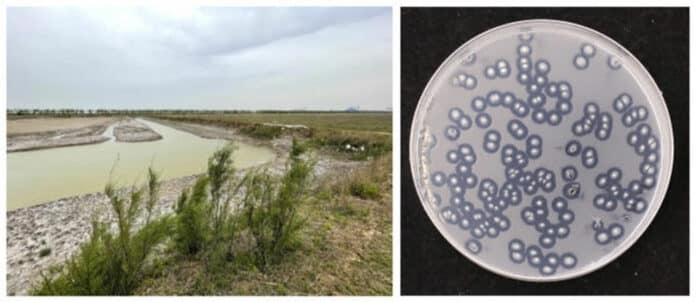As a relatively new material given to the marine ecosystem, plastic debris provides a substrate for microbes that last much longer than most natural floating materials. Some plastics, especially biodegradable ones, and plasticizers, can also directly provide carbon sources for microbes to metabolize. Also, no specific taxonomic groups are known to only or even predominantly colonize plastic surfaces.
Multiple studies have demonstrated how the microbiomes associated with plastics differ from those present in the surrounding environment. A new concept, “plastisphere,” was proposed where an overrepresentation of bacteria and fungi from Chytridiomycota has been noted.
Researchers from the Royal Botanic Gardens, Kew scientists have discovered a rich microbiome of organisms that break down plastic in the coastal salt marshes of Jiangsu, China.
The biodegradable polyester polycaprolactone (PCL), frequently used in creating different polyurethanes, may be broken down into 184 fungal and 55 bacterial strains, according to the worldwide team of experts. Of these, bacteria from the genus Jonesia and the genus Streptomyces can further deteriorate petroleum-based polymers, either man-made or natural chains of molecules joined together.
In May 2021, samples of the microbes that break down plastic was taken from Dafeng in eastern China, a UNESCO-protected location close to the Yellow Sea Coast. Given that previous research has mainly concentrated on marine environments, the sample confirmed the term “terrestrial plastisphere,” which is relatively new to terrestrial ecology. Furthermore, it was discovered that the microbiome of this “man-made ecological niche” of coastal plastic garbage differed from the soil in the vicinity.
Microorganisms, like fungi and bacteria, are receiving more attention from scientists to address some of the most urgent issues of the modern day, such as the growing problem of plastic pollution. The United Nations Environment Programme (UNEP) estimates that 400 million tonnes of plastic garbage are created each year, with levels of plastic pollution sharply rising since the 1970s. However, scientists are optimistic that the plastisphere will solve this issue.
To date, 436 species of fungi and bacteria have been found to degrade plastic. According to scientists, their study could lead to the development of efficient enzymes designed to degrade plastic waste biologically.
Dr. Irina Druzhinina, Senior Research Leader in Fungal Diversity and Systematics at RBG Kew, says: ‘Microbiologists across the board feel responsible for finding solutions to the ecologically friendly treatment of plastic waste because bacteria and fungi will be the first organisms to learn how to deal with this new material. We have no doubt that microbes will figure out ways to effectively degrade plastic, but this may take thousands of years if we leave nature to run its course. That is why our task is to utilize our knowledge of microbial biology to speed up and direct the evolution of microbes and their genes to do the job now.’
The plant pathogens Fusarium and Neocosmospora were among the 14 genera of fungi that the researchers found in the samples. While drawing their nutrition from plants, plant-pathogenic fungi destroy their host. The study’s results suggest that these fungi may be more capable of degrading PCL plastics and other synthetic polymers than saprotrophic fungi, which feed on dead plant and animal remains.
Dr. Druzhinina adds: ‘The ecological niche of the Dafeng salt marshes is precisely why we chose to investigate the microbial communities in plastic waste there. So far, our findings have proven exciting and promising.’
The study group identified two genera of bacteria, Streptomyces and the recently discovered genus Jonesia, as viable candidates for plastic degradation in addition to the fungi at Dafeng. In particular, the species Jonesia cf. Quinghaiensis dominated the 55 sampled bacterial strains.
Xuesong Li, a Master’s Student at Nanjing Agricultural University, China, says: “The opportunity to work on a project with potentially impactful solutions to tackling rising levels of plastic pollution across the globe was an immediate draw, particularly as this was my first research project. There was some initial concern we might not gather enough data from a single sampling.”
“Still, the results so far have been overwhelming, and we have had to restrain ourselves from isolating more and more cultures to study their characteristics. And though bacteria proved highly active in this regard, I favored working with fungi, as these organisms have vast potential for applications far beyond plastic degradation.”
Dr. Feng Cai, Sun Yat-sen University in Shenzhen, China, says: “What strikes me the most is the sheer power of microbial diversity, especially if you consider how challenging it is to detect them; they are microscopic in size, secretive in nature, and simple in appearance. However, when we shift our perspective and view them through a biochemical lens, we access an abundant complexity that awaits our exploration.”
“It is truly exhilarating to realize we have barely scratched the surface and have already discovered a wealth of potentially promising resources for future technologies. This realization fills me with an incredible sense of satisfaction, knowing that numerous discoveries are still to be made and that our work can potentially lead to significant advancements in the field.”
Journal Reference:
- Guan Pang, Xuesong Li, et al. The distinct plastisphere microbiome in the terrestrial-marine ecotone is a reservoir for putative degraders of petroleum-based polymers. Journal of Hazardous Materials. DOI: 10.1016/j.jhazmat.2023.131399
